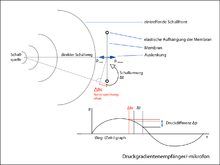Proximity effect
The proximity effect , and proximity effect , proximity effect or proximity effect called, is an overemphasis (higher sensitivity ) of low frequencies with directional microphones ( pressure gradient ) in the near field of a sound source. In combination with the usual, technical bass boost, which actually serves the purpose of compensating for the weak recording of pressure gradient microphones at low frequencies, the result is a voluminous sound. This bass boost is usually undesirable, but can also be used as an artistic design of the sound, e.g. B. to generate a full singing voice.
Occurrence of the effect
The proximity effect occurs when a pressure gradient microphone is located close to the sound source . Dense means within about one wavelength. Since the near field is shorter for low frequencies, i.e. long wavelengths, than for high frequencies, the low frequencies are overemphasized in close discussions.
In the case of double-diaphragm microphones, which consist of two pressure gradient receivers opposite one another, the proximity effect also occurs, albeit to a lesser extent, when they are connected together electrically in such a way that the pair has an omnidirectional characteristic like a pressure microphone . A pair of pressure microphones, which are interconnected in such a way that the pressure gradient takes effect, also shows the effect.
If, on the other hand, pressure microphones are interconnected as a microphone array , i.e. with technical signal delays that compensate for the different distance from the sound source, the effect does not occur.
The effect can be reduced in use
- due to a larger recording distance;
- by holding the directional microphone with cardioid polar pattern perpendicular to the main direction, because then it is insensitive to the pressure gradient, acts as a pressure microphone;
- through electrical filters (bass reduction).
Competing explanations
According to some sources, the strong curvature of the spherical sound wave near the sound source is the cause. If such a strongly curved wave front hits a pressure gradient receiver, the sound pressure difference (the sound pressure difference) between the front and back arises in two ways: In the far field, the different distances that the sound wave has to travel to the front and back causes one to the frequency proportional pressure difference. This path difference increases due to the curvature of the wave front. This results in an increase in the pressure gradient and the membrane is deflected more strongly. This mechanism does not explain the occurrence of the effect for small diameters of the microphone capsule.
In the far field of the sound source, sound pressure and sound velocity are "in phase"; In the near field of the sound source, the sound pressure and sound velocity are shifted in phase up to a maximum of 90 °. It should be said that pressure gradient receivers are also sensitive to the speed of sound, depending on the moving mass and rigidity of the membrane, and that for spherical sound waves, the speed of sound and the pressure gradient in the near field decrease by 1 / r² (in the far field by 1 / r, like the sound pressure in Near and far field).
literature
- Thomas Görne: Microphones in theory and practice. 8th, new, revised and expanded edition. Elektor-Verlag, Aachen 2007, ISBN 978-3-89576-189-8 .
- Norbert Pawera: Microphone Practice . Tips and tricks for stage and studio. Technology, acoustics and recording practice for instruments and vocals. 4th, completely revised and expanded edition. PPV-Medien, Bergkirchen 2003, ISBN 3-932275-54-3 .
- Fritz Kühne: mono, stereo and transistor microphones. 7th edition, Franzis Verlag, Munich, 1966
See also
- Directional pattern | Microphone | Pressure gradient microphone | Pressure microphone | Distance law | Boundary microphone
